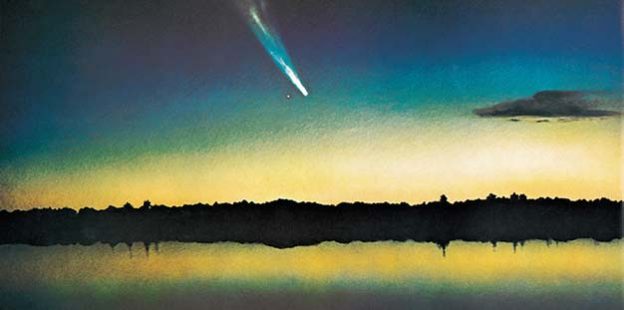On March 7, 1973, a Czech astronomer was photographing asteroids at the Hamburg Observatory in Germany when he stumbled upon a previously undetected comet some 465 million miles from the sun. Formally designated C/1973 E1, it was named after the astronomer who discovered it, Dr. Lubos Kohoutek (pronounced “Ko-ho-tek”).
If you are of a certain age, you may remember Kohoutek. Astronomers predicted that it would be “the comet of the century.” By the end of the year, as Kohoutek neared the sun, it was forecast to be so bright that it would be visible to the naked eye even in full daylight. Then, in January 1974, having switched over to the evening sky, it would create a spectacular display, easily visible even in the relatively bright skies of the world’s biggest cities.
By mid-summer, Comet Kohoutek had entered into popular culture, with t-shirts, books, hats, and all other manner of memorabilia flooding the market. Special viewing tours were being arranged, including a three-day cruise on the Queen Elizabeth II. The craze lasted for the rest of the year, as anticipation built for Kohoutek’s appearance. In its December 17 issue, Time reported, “[Kohoutek] promises to rival and perhaps surpass in brightness Halley’s comet, which last appeared in 1910 and will not be seen again until 1986. By the time Kohoutek emerges from its passage behind the sun early in January, its tail should be full grown, a glittering streamer extending across as much as a sixth of the evening sky.” Popular Science was onboard, too, running an article in November titled, “Get Set for the Sky Spectacular of the Century,” along with a depiction of what Kohoutek would look like in the evening sky.
 Helmut Wimmer, photo credit Sandi Kitt.
Helmut Wimmer, photo credit Sandi Kitt.As Brian remembers, “We went to see the laser show there—they had one of the first laser shows—because I was thinking, what could we do to kick stuff up a notch?” While there, they saw the perfect cover for Weather Report’s new album: a painting of a comet over Madagascar created by Helmut Wimmer, an artist who produced vivid large-scale depictions of celestial objects for the planetarium in the pre-digital and pre-space telescope days. Wimmer, the planetarium’s staff artist from 1954 to 1987, produced hundreds of paintings on cardboard sheets, which were then photographed on transparency slides and loaded into projectors on the perimeter of the planetarium’s 48-foot-high dome.
Meanwhile, as December turned into January (when Mysterious Traveller was recorded), Kohoutek turned out to be a dud. According to the January 16, 1974 New York Times, “Kohoutek, once touted as ‘the comet of the century,’ made its closest approach to the earth yesterday, coming within 75 million miles, but few residents of this planet saw it. That, as a celestial ‘spectacular,’ it was a flop, according to astronomers, demonstrates that, while the paths of comets can be predicted with great precision, their behavior cannot.”
It wouldn’t do to name Weather Report’s new album after a cosmic dud, so the title was changed to Mysterious Traveller, adopting the British spelling of the second word. Wayne likened the comet to “a mysterious visitor” and he attributed extra meaning to the coming of Kohoutek. “It was a mystery about where was it born, and that means our life too, here we are: all mysterious travelers,” he told Jazz Times in 2002. In addition, The Mysterious Traveler was the title of a fantasy/science fiction radio show and comic book that Wayne remembered from his youth, so like I Sing The Body Electric, he co-opted the title for the album.
Nowadays, Kohoutek has pretty much been forgotten altogether. Fortunately, we can still enjoy the beautiful cover that it inspired for one of Weather Report’s best albums.


















